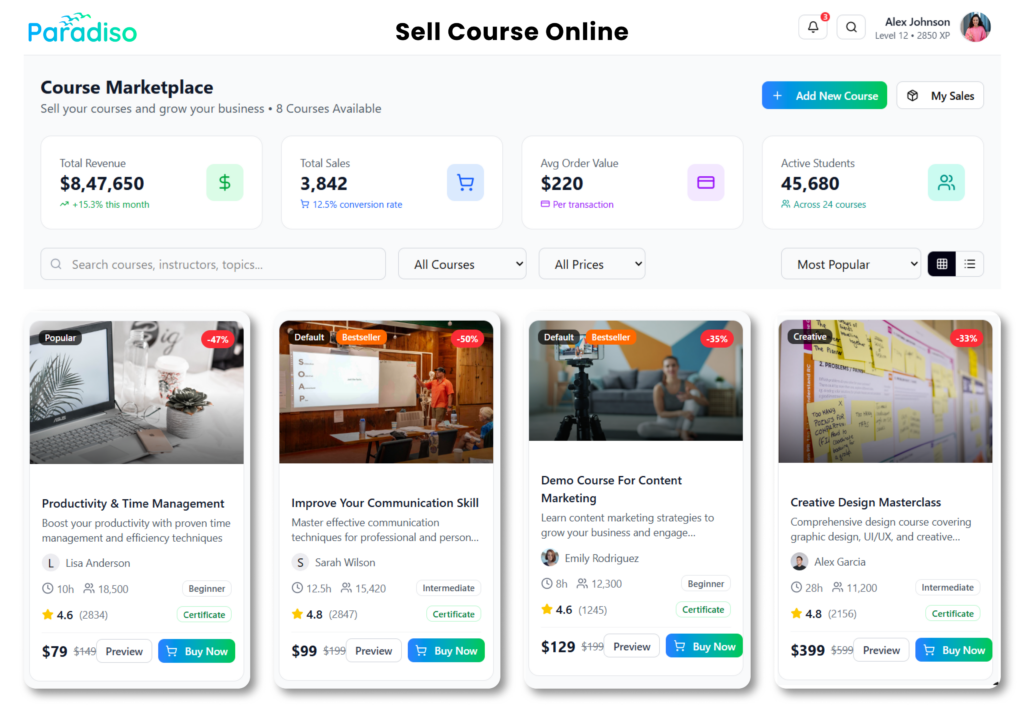The eLearning industry is constantly evolving and in 2023, several new trends are expected to take the forefront. These include the integration of microlearning, AI and machine learning, virtual and augmented reality, gamification, and social learning into the eLearning experience. Other trends include the use of video-based learning, personalized and adaptive learning, micro-credentials and digital badges, online tutoring and mentoring, and remote and online learning. These trends aim to enhance the effectiveness and engagement of eLearning, making education more accessible and personalized for learners.
E-Learning trends for 2023.
Keeping an eye on what’s happening in the eLearning industry and deep diving in the valuable insights we have from thousands of our customers and their eLearning courses and online academies, we have uncovered the top 10 eLearning trends for 2023.
1. Learning Experience Platform (LXP)
A Learning Experience Platform (LXP) is a technology solution that provides a personalized and interactive learning experience for employees or students. It goes beyond traditional learning management systems (LMS) by incorporating features such as social learning, gamification, personalized recommendations, and micro-learning to enhance engagement and motivation. LXP integrates various digital tools, such as videos, quizzes, and interactive modules, to provide a comprehensive and engaging learning experience. It also provides insights into the learning progress and preferences of individual users, allowing organizations to make data-driven decisions about their training and development programs.2. Mobile-First Learning
Mobile-First Learning is a learning approach that prioritizes the use of mobile devices, such as smartphones and tablets, as the primary platform for delivering educational content and resources. This approach recognizes the increasing use of mobile devices in daily life and the potential they offer for providing learners with anytime, anywhere access to learning materials. In Mobile-First Learning, educational content is optimized for mobile devices, with a focus on delivering bite-sized, easily digestible pieces of information, known as microlearning. This allows learners to access and engage with learning content at their own pace, whether they are on the go or in a more traditional learning environment.3. Assessment is Changing
The process of evaluating learning and measuring progress is undergoing significant changes in recent years. Traditional methods of assessment, such as multiple-choice tests and written exams, are being replaced with more interactive and engaging approaches that provide a more comprehensive view of a learner’s skills and abilities. One of the key changes in assessment is the shift towards formative assessment, which focuses on providing feedback to learners during the learning process. It helps learners identify their strengths and weaknesses, and make improvements in real time, rather than waiting for the end of a course or program.4. Hybrid Learning
Hybrid Learning combines Of traditional in-person instruction with online learning Education. This approach provides learners with the benefits of both face-to-face interaction and the flexibility and accessibility of online learning. A hybrid learning environment includes students attending some classes in a physical classroom setting, and others online. It allows for a mix of traditional instruction, group work, and individual activities, and provides learners with the opportunity to learn at their own pace.5. cohort-based learning
In a cohort-based learning environment, learners progress through a course or program together, with a shared curriculum and set of learning outcomes. This allows for a more structured and supportive learning experience, with learners able to benefit from the knowledge and perspectives of their peers.6. Micro-credentials
Micro-credentials are a form of digital certification that recognize and validate the skills and knowledge learners have acquired through various learning experiences, both formal and informal. They are designed to be bite-sized, flexible, and stackable, allowing learners to demonstrate and showcase their achievements in a specific area. Micro-credentials are becoming increasingly popular as a way for learners to demonstrate their skills and knowledge in a specific area, as well as a way for organizations to recognize and reward employee development. They provide a more flexible and accessible alternative to traditional degrees and certifications, and can help learners stay current and competitive in an ever-evolving job market.7. Subscriptions & Memberships
Subscriptions and memberships are models of delivering and accessing educational content, where learners pay a recurring fee to access a wide range of courses, resources, and services. This approach provides learners with a flexible and cost-effective way to upskill and reskill and helps organizations offer ongoing learning and development opportunities. This Also Includes learners having access to a wide range of content and resources, with online courses, videos, live events, and more. They can progress through the material at their own pace and access resources and support as needed. This provides learners with a flexible and self-directed learning experience and allows them to focus on the areas that are most relevant and important to them.8. Artificial Intelligence (AI)
Artificial Intelligence (AI) is a branch of computer science focused on creating machines that can perform tasks that normally require human intelligence, such as recognizing patterns, making decisions, and understanding natural language. AI is revolutionizing the way we live, work, and learn, and is having a major impact on the field of education. AI in eLearning is also beneficial and time-saving for the creator. AI tools automate tons of tasks like content translation, content tagging and grouping, assigning courses to users to courses, and quiz generation. And, of course, one of the top functionalities of AI is in-depth data analysis. Learning analytics tools will shed light on every aspect of an online course and learner behavior, enabling training providers to improve their offerings.9. Augmented Reality (AR) and Virtual Reality (VR)
Augmented Reality (AR) and Virtual Reality (VR) are technologies that use computer-generated images, sounds, and other sensory inputs to enhance or completely replace the physical environment. In the education sector, AR and VR are being used to create immersive and engaging learning experiences, providing students with new and innovative ways to explore, learn, and interact with the world. VR includes learners can be transported to a fully-realized virtual world where they can experience simulations, simulations of historical events, and more.10. Data analysis
Data analysis is extremely essential for eLearning, especially in corporate training and higher education. Predictive analytics uses past data to predict future learner behavior, often with the help of AI, which analyzes the data collected and turns it into reliable forecasts. Data analysis can massively improve learning effectiveness. It can direct learners to the learning material they like the most and the content that helps them learn faster and more effectively. It can also identify declining performance and notify the instructor so that they can offer timely help to the learner.Final thoughts-
The field of education is undergoing significant changes and there are several emerging trends that are set to go big in 2023. The trend is shaping the way we approach education and providing new opportunities for learning and growth. By staying up-to-date with trends and incorporating them into our educational programs and practices













